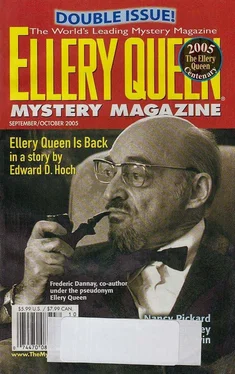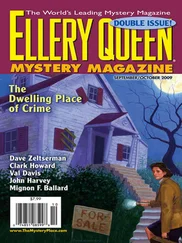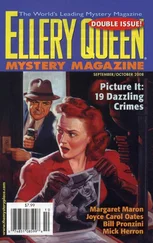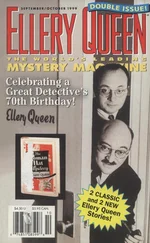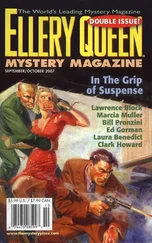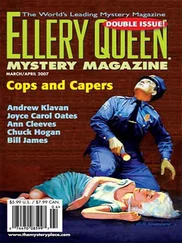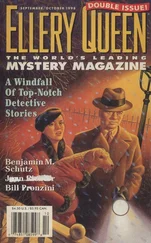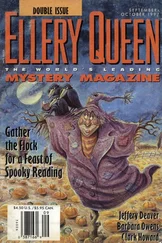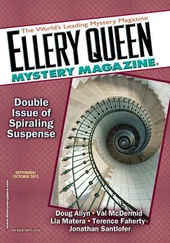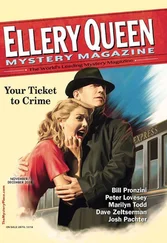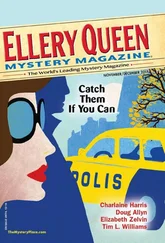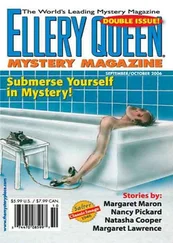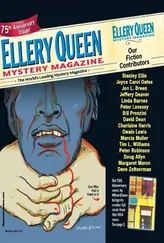Тимоти Уилльямз - Ellery Queen’s Mystery Magazine. Vol. 126, No. 3 & 4. Whole No. 769 & 770, September/October 2005
Здесь есть возможность читать онлайн «Тимоти Уилльямз - Ellery Queen’s Mystery Magazine. Vol. 126, No. 3 & 4. Whole No. 769 & 770, September/October 2005» весь текст электронной книги совершенно бесплатно (целиком полную версию без сокращений). В некоторых случаях можно слушать аудио, скачать через торрент в формате fb2 и присутствует краткое содержание. Город: New York, Год выпуска: 2005, Издательство: Dell Magazines, Жанр: Детектив, на английском языке. Описание произведения, (предисловие) а так же отзывы посетителей доступны на портале библиотеки ЛибКат.
- Название:Ellery Queen’s Mystery Magazine. Vol. 126, No. 3 & 4. Whole No. 769 & 770, September/October 2005
- Автор:
- Издательство:Dell Magazines
- Жанр:
- Год:2005
- Город:New York
- ISBN:нет данных
- Рейтинг книги:4 / 5. Голосов: 1
-
Избранное:Добавить в избранное
- Отзывы:
-
Ваша оценка:
- 80
- 1
- 2
- 3
- 4
- 5
Ellery Queen’s Mystery Magazine. Vol. 126, No. 3 & 4. Whole No. 769 & 770, September/October 2005: краткое содержание, описание и аннотация
Предлагаем к чтению аннотацию, описание, краткое содержание или предисловие (зависит от того, что написал сам автор книги «Ellery Queen’s Mystery Magazine. Vol. 126, No. 3 & 4. Whole No. 769 & 770, September/October 2005»). Если вы не нашли необходимую информацию о книге — напишите в комментариях, мы постараемся отыскать её.
Ellery Queen’s Mystery Magazine. Vol. 126, No. 3 & 4. Whole No. 769 & 770, September/October 2005 — читать онлайн бесплатно полную книгу (весь текст) целиком
Ниже представлен текст книги, разбитый по страницам. Система сохранения места последней прочитанной страницы, позволяет с удобством читать онлайн бесплатно книгу «Ellery Queen’s Mystery Magazine. Vol. 126, No. 3 & 4. Whole No. 769 & 770, September/October 2005», без необходимости каждый раз заново искать на чём Вы остановились. Поставьте закладку, и сможете в любой момент перейти на страницу, на которой закончили чтение.
Интервал:
Закладка:
Ellery Queen’s Mystery Magazine. Vol. 126, No. 3 & 4. Whole No. 769 & 770, September/October 2005
The Misadventures of Ellery Queen
by Jon L. Breen
I confess I stole the title of this piece, but it was inevitable. Ellery Queen (certainly the Frederic Dannay half and maybe the Manfred B. Lee half as well) showed his/their love of parodies and pastiches by editing a whole volume of them, The Misadventures of Sherlock Holmes (1944), which included serious tributes such as Vincent Starrett’s classic “The Unique Hamlet” alongside comical cases for sleuths with names like Sherlaw Kombs, Holmlock Shears, Hemlock Jones, and Picklock Holes. The less-than-amused guardians of the Arthur Conan Doyle estate managed to get that Holmes anthology suppressed. Undeterred, editor Queen would publish many parodies and pastiches over the first forty years of this magazine and especially enjoyed those in which the target was Queen him/themselves. The title “The Misadventures of Ellery Queen” was first used on a survey article by Marvin Lachman in the August 1969 issue of The Queen Canon Bibliophile, a short-lived but significant fanzine edited by the Rev. Robert E. Washer, and later on a proposed anthology, an unrealized 1980s project of Josh Pachter.
In a parody, an author’s style is imitated for comic effect. In a pastiche, the characters and backgrounds of another writer are used in serious imitation of the style. Since elements of homage and mockery often coexist, editor Queen sometimes called the stories parody-pastiches. A third category beloved of editor Queen was the indirect pastiche, in which the style and characters may be different but the source of influence is explicit.
The earliest EQ parody in EQMM kidded not Queen the author but Queen the editor. In the March 1947 issue, Baynard Kendrick’s takeoff on true-crime articles, “The Case of the Stuttering Sextant,” was introduced by Clayton Rawson (a former True Detective editor who would later be a managing editor of EQMM ) in the style of a Queenian story note: “’Tec fans will greet this epoch-making masterpiece of murder with huzzas and dancing in the streets (white tie). EQMM fans will be tickled pink to learn the story has not previously appeared in any other language (including the Sanskrit)...”
As Lachman points out, most of the early parodies in EQMM were Sherlockian in nature, and while EQ the sleuth appears as a supporting player in some of them, the first writer to do a story starring a parody Ellery was Arthur Porges. Celery Green, an American sleuth traveling in Britain, assists Inspector Dewe East in two broadly comic stories, “The English Village Mystery” (December 1964) and “The Indian Diamond Mystery” (June 1965). The detective’s given name allows him to stalk off at the end of each case.
I first broke into print in this magazine in the late ’60s as a parody-pastiche specialist. After buying stories in imitation of Ed McBain, Burt L. Standish, and S. S. Van Dine, Fred Dannay asked if I would like to do a Queen parody, and I responded with my fourth published story, “The Lithuanian Eraser Mystery” (March 1969), a theatrical dying-message puzzler about E. Larry Cune, surely one of the more strained Queenian parody names. I would return to the character twice in EQMM — “ The Swedish Boot Mystery” (November 1973) and “The Adventure of the Disoriented Detective” (September 1976) — and once in The Queen Canon Bibliophile — “ The Idea Man” (August 1969) — always ringing changes on the old dying-message ploy.
In the April 1971 Wilson Library Bulletin, David Peele’s “The Cataloging on the Wall” finds librarian Quellery Een in his office holding “his treasured first edition of the Viking Portable Mickey Spillane” and interviewing candidates to replace his deceased cataloger Slinki Porter. A Challenge to the Reader is included, and a library-school graduate might indeed figure out how he decided Elsie Dinsmore was the girl for the job. Funny stuff but likely to puzzle non-librarians.
One of the cleverest send-ups of the Queen style was also one of the least widely distributed, “The Persian Fez Mystery; or The Tragedy of Q” from Joe R. Christopher’s 30-copy chapbook Queen’s Books Investigated; or, Queen Is in the Accounting House (1983), wherein it is revealed that Elroy Queep “only in his novels... solved the cases before the police; in real life his suggestions were always wrong.”
Pure pastiches of Ellery Queen have been relatively rare. The earliest may be one chapter of Marion Mainwaring’s 1954 novel Murder in Pastiche; or, Nine Detectives All at Sea. Despite the use of assumed names for the various great detectives traveling on the same ocean liner, Mainwaring’s imitations are generally straight-faced. Ellery, under the name Malory King, joins detectives based on Hercule Poirot, Sir John Appleby, Perry Mason, Roderick Alleyn, Nero Wolfe, Miss Silver, Mike Hammer, and Lord Peter Wimsey in addressing a shipboard mystery. The author is a splendid literary mimic, capturing the stylistic quirks of her various subjects. Many years later, she would apply this knack to the completion of a novel left unfinished by Edith Wharton, The Buccaneers (1993).
The stories Norma Schier wrote in imitation of famous detective-story writers were more pastiche than parody, but the names of the sleuths and the authors’ names attached were anagrams of the originals. The stories would be collected under the title The Anagram Detectives (1979), one of the earliest products of Otto Penzler’s Mysterious Press. EQ author and character became Leyne Requel in the story “Dying Message” (July 1966), a clever example of the titular gambit. All the other character names are anagrams as well, leading to such unusual handles as Carson Pellicot and Porter Oattes.
Despite the assumed name given the character, Dennis M. Dubin’s “Elroy Quinn’s Last Case” (July 1967), written when the author was a high-school senior, is also more pastiche than parody. The ageing sleuth is asked into a case with international implications by Inspec-tor Thomas Velie, Jr. Since the name Velie is not changed and various authentic Queen titles appear as supposed Quinn titles, I wonder if it was at the request of editor Queen that Ellery’s name was changed.
Francis M. Nevins’s brilliant first story, “Open Letter to Survivors” (May 1972), begins with the following epigraph from Ellery Queen’s Ten Days’ Wonder (1948): “...there was the case of Adelina Monquieux, his remarkable solution of which cannot be revealed before 1972 by agreement with that curious lady’s executors...” References to unrecorded cases, so common in the Sherlock Holmes canon, are rare in the Queen writings. Though the name Ellery Queen never appears in the text itself (his own idea, says Nevins, not Fred Dannay’s), the identity of the author/sleuth is obvious, and the story has a stature among Queen pastiches comparable to Vincent Starrett’s “The Unique Hamlet” among Holmes pastiches.
Ellery appears more or less under his own name in Julian Symons’s Great Detectives: Seven Original Investigations (1981), in which Ellery (pince-nez in place) and his father are given a distinctly old-fashioned look in Tom Adams’s illustrations. Taking a Sherlockian mock-scholarly approach, Symons opines that the Ellery of all the books after Halfway House (1936) was in fact a younger brother of the original, less pretentious but also less gifted. That younger brother, Dan Queen, solves a mid-twenties mystery as related by J. J. McCue, the family friend who introduced the early Queen novels. (Fred Dannay, to whom Symons sent the manuscript, admitted to being amused but offered no further comment.)
Читать дальшеИнтервал:
Закладка:
Похожие книги на «Ellery Queen’s Mystery Magazine. Vol. 126, No. 3 & 4. Whole No. 769 & 770, September/October 2005»
Представляем Вашему вниманию похожие книги на «Ellery Queen’s Mystery Magazine. Vol. 126, No. 3 & 4. Whole No. 769 & 770, September/October 2005» списком для выбора. Мы отобрали схожую по названию и смыслу литературу в надежде предоставить читателям больше вариантов отыскать новые, интересные, ещё непрочитанные произведения.
Обсуждение, отзывы о книге «Ellery Queen’s Mystery Magazine. Vol. 126, No. 3 & 4. Whole No. 769 & 770, September/October 2005» и просто собственные мнения читателей. Оставьте ваши комментарии, напишите, что Вы думаете о произведении, его смысле или главных героях. Укажите что конкретно понравилось, а что нет, и почему Вы так считаете.
